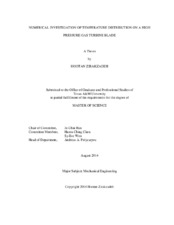| dc.description.abstract | A numerical code is developed to calculate the temperature distributions on the surface of a gas turbine blade. This code is a tool for quick prediction of the temperatures by knowing the boundary conditions and the flow conditions, and doesn’t necessarily provide the most accurate results that could be obtained by performing an experiment or precise CFD simulations. Different systems of blade external and internal cooling, such as rib turbulated cooling, impingement cooling, pin-fins, and injection holes for film cooling, are considered in the code by using the appropriate correlations or factors.
When the code is run and the results are obtained a gas turbine blade designer can modify his blade terms and conditions such as mass flow rate, number of injection holes in each passage, even the blade material thickness to find an optimum design for cooling purposes. Code is first applied to an E³ blade; the external heat transfer coefficients for this blade is inserted as a known boundary condition; Next, code is run for the same blade but this time using the flat plate and convectional correlations for predicting transition on suction side of the blade for external heat transfer coefficient. This code provides an easy way to get a better understanding of the cooling design and its ability to be modified for any gas turbine blade makes it more flexible to be developed as a commercial tool in future. In the next step, code is applied to a Samsung-Rotor2 blade with different cooling design than an E³ blade and results are presented. Another part is introduced to this project by running a CFD simulation using commercial software Fluent and Gambit, to capture heat transfer coefficient distributions around the surface of the blade and the obtained values is used back in the code. In the meanwhile some interesting observations made during the CFD simulation is discussed. The CFD simulation is performed for the cases where there are not any data available for external heat transfer coefficient distribution already. Two turbulence models, k-epsilon and SST-Transition were utilized for the 2D CFD study; and for the 3D CFD case, only k-epsilon model was applied. It was revealed that even though SST- Transition has a better prediction of Mach number, but in terms of heat transfer coefficient k-epsilon model provides closer values to the reference values from previous works. Finally, combining the code and the CFD results could act as a useful assistant to give a designer a general and quick idea of how his blade design will perform at the end. | en |


